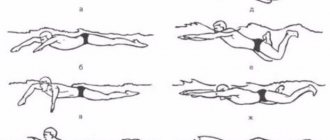With age, the pelvic muscles become less elastic and lose elasticity, and therefore cannot fully support the structures of the small pelvis, including the uterus, in the desired position. This process is accelerated by repeated pregnancies, childbirth, hormonal disorders, and increased intra-abdominal pressure. To give strength to the intimate muscles, specific gymnastics were created for prolapse of the uterus; its illustrations in pictures will help you perform all the exercises without errors.
Stages of the disease
There are cases of sudden diagnosis of uterine prolapse. As a rule, this occurs due to injury, but in general the problem develops gradually, not occurring overnight. As the disease progresses, 4 degrees of its development are determined.
In the first stage, the uterus is lowered to the level of the vagina, but it does not extend beyond the perineum.
The second level is characterized by partial prolapse of the uterus. If the muscles are tense, it may peek out from the genital slit. Already at this stage, the disease can be easily diagnosed by the woman herself.
In the third degree, incomplete prolapse of the genital organ is diagnosed. Without tension, the cervix and part of the uterus are visible.
And the last, most complex form of pelvic organ prolapse is the fourth. At this stage, the entire body of the uterus emerges from the perineum.
Who is at risk?
Uterine prolapse can occur in any woman. But most often it occurs in such cases:
- burdened heredity;
- numerous births;
- congenital defects of the genital organs;
- pelvic injuries;
- surgical interventions on the genital organs;
- hard physical labor;
- obesity in the presence of large amounts of visceral fat.
Also at risk are women of menopausal age.
In addition, uterine prolapse can occur as a result of prolonged and frequent constipation, severe coughing, and physical inactivity.
Symptoms of pelvic organ prolapse
Signs of uterine prolapse are quite noticeable, and it is impossible not to pay attention to them.
- Feeling of heaviness in the vagina.
- Frequent, difficult urination and defecation.
- Painful sensations for both partners during sexual intercourse.
- Uncharacteristic vaginal discharge, often mixed with blood.
- Irregularities in the menstrual cycle with heavy bleeding.
Starting from the second degree of the disease, a woman can easily identify genital prolapse herself. As the disease progresses, the signs of uterine prolapse become even more noticeable and worsen. Urinary incontinence occurs, the woman is susceptible to urological infectious diseases such as cystitis, pyelonephritis, urethritis.
Basic principles and rules
As you know, uterine prolapse is a disease that progresses over time. If the factor underlying the development of the pathology is not eliminated, we should expect a worsening of the condition. Most causes of uterine prolapse are controlled events that lead to an increase in intra-abdominal pressure and, accordingly, put stress on the supporting apparatus of the uterus. They are primarily related to lifestyle: dietary habits, physical activity, working conditions, and so on.
A woman should avoid any factors that provoke an increase in intra-abdominal pressure. Thus, lifting weights is prohibited with prolapse of the uterus (this concept implies loads weighing more than 5 kilograms). Intense physical activity is excluded. If your work involves constant movement and overexertion, it is recommended to think about looking for another place to work.
Patients should get more rest. If you feel tired when visiting a supermarket, for example, sit down for a couple of minutes and rest. When doing gymnastics, also follow this principle so as not to overload the body. Optimize your sleep and eliminate lack of sleep, try to sleep at least 8 hours a day. Try to avoid stressful situations and worries.
Coughing and sneezing, due to contraction of the diaphragm, also provokes an increase in pressure in the abdominal cavity. Therefore, respiratory tract infections and colds should be treated accordingly.
Women have many questions regarding pregnancy planning. In the early stages of uterine prolapse, sexual intercourse is quite possible and the patient may not feel any unpleasant symptoms. Accordingly, conception is possible. But bearing a fetus will lead to the inevitable progression of uterine prolapse, since the organ significantly increases in volume and weight, and the supporting apparatus cannot cope with such a load. Therefore, pregnancy in women with uterine prolapse is undesirable; procreation is best planned after treatment.
Diagnosis of the disease
At the first stage, a woman cannot independently recognize this problem. Systematic observation by a gynecologist is important. After examining the woman, the doctor immediately diagnoses uterine prolapse. If for some reason he has doubts, he will refer you for an ultrasound examination, based on the results of which a decision will be made. Early diagnosis will prevent a painful syndrome and provide the possibility of treatment without surgery. To exclude all types of infections that could become concomitant factors for prolapse, you need to visit a urologist and proctologist.
There are two types of pelvic organ prolapse. A cystocele is a prolapse of the anterior wall of the uterus and is characterized by symptoms from the urinary system. Stagnation of urine or incontinence develops, and chronic cystitis is often observed. The second type of prolapse is rectocele, which is a prolapse of the posterior wall of the uterus. In this case, women experience intestinal dysfunction, chronic constipation, and sensations of a foreign body in the vagina. Pyelonephritis with prolapse of the posterior wall also becomes a frequent occurrence.
Therapeutic physical education Atarbekova
This version of therapeutic exercises is widely used by women suffering from weakness of the pelvic floor muscles and prolapse of the pelvic organs, since all the exercises are safe, do not cause discomfort, and are easy to perform. They also serve for the correct formation of the muscular corset of the torso and limbs.
Training according to Atarbekov in a standing position:
- We imitate walking in place, raising our knees higher;
- We alternately perform backward swings with the lower limbs, while simultaneously throwing our arms up;
- Traditional “swallow” stance - we tilt the body parallel to the floor, move one leg back to a horizontal position, stand at this time on the other leg, stand like this for 10 seconds if possible, after which you change legs;
- We bend over to the right and then to the left leg, reaching with our hands to the big toes;
- Leaning to the right, we reach for the right foot with our left hand, and at this moment we extend our right hand upward. Repeat on the other side;
- Standing on one leg, we lift the other forward and up and, as it were, “draw” a circle with the toe in a clockwise direction, then we change legs.
There are also trainings according to Atarbekov, carried out while sitting:
- We spread our legs wider, bend our whole body first to the right, then to the left leg, reach the right foot with the fingers of the opposite hand, and at this time extend the same hand upward;
- In the same way, we reach with both hands, first to one and then to the other leg, alternately;
- We lean forward with our whole body, towards straight legs, pointing our fingers towards our toes;
- We roll onto our backs, bending our legs to our chin, and return back to a sitting position.
Childbirth and prolapse: how to avoid the disease?
Prolapse of the uterine walls is a common occurrence during pregnancy or after childbirth. This is due to hormonal changes in the body. Under their influence, the uterus softens, preparing for childbirth, its muscles weaken. During pregnancy, a woman needs to be more prudent and adhere to certain rules to prevent genital prolapse, especially if she has encountered this problem before.
- Exercise. Various exercises need to be done. If the uterus prolapses, even not to a significant extent, they will not allow further development of the disease.
- Protect yourself from heavy lifting. Including, if you have a small child, try to shift the mission of carrying the baby to other relatives.
- Wear a bandage daily if the uterus has prolapsed or to prevent the development of the disease.
- Stick to a balanced diet.
- During one urination, squeeze the stream several times, thus performing gymnastics for the genitals.
- While walking, tense and relax the vaginal muscles, thereby tightening the vulva.
The doctor must deliver the baby in a conservative manner, minimizing trauma to the woman’s organs.
When can I expect results?
If you started exercising 4-8 weeks after giving birth - or immediately after diagnosis - you can expect improvements after 2-3 months of daily exercise. These terms are called by the attending physicians - in the case when you use cones, balls or Kegel exercisers with feedback.
An accelerated option is electronic stimulators. They train the internal muscles in a “lazy” way - they send micro-impulses and do not require conscious effort from you. Such devices are expensive, but they give results in 2-3 weeks.
Treatment of uterine prolapse at home
Pregnant women are wondering how to treat uterine prolapse after learning this diagnosis at an appointment with a gynecologist. If the disease is at an early stage and it does not harm the child, in addition to preventive actions, no additional actions are required. If desired, some folk methods will not harm.
For example, you can brew two tablespoons of lemon balm in a glass of boiling water and leave it in a thermos overnight to steep. Take a third of a glass half an hour before meals. This decoction will be useful for diseases of the genital organs and for the nervous system of a pregnant woman.
Second option: mix coltsfoot with lemon balm and oregano in equal proportions, pour boiling water over it. Let the infusion brew and drink 2/3 cup before meals.
Also, the bandage will become an indispensable assistant for prolapse of the uterus. In general, this item should be in the everyday life of every woman expecting a baby, and even more so for those who are faced with the problem of genital prolapse.
Another folk remedy in the fight against this disease is a bath with cypress decoction. Boil a glass of nuts in two liters of water, add this infusion to a warm bath, but not a hot one, stay in it for 15 minutes a day.
It is not uncommon for the uterus to prolapse after childbirth. Photos are sometimes terrifying in what a neglected form can lead to. Therefore, if you are affected by this problem after the birth of your baby, do not put off solving it for later, go to the doctor! Only a gynecologist can prescribe quality treatment and prevent the disease from developing to the fourth degree.
Yoga classes
It is necessary to use yoga during uterine prolapse in consultation with a doctor or trainer, since some asanas can be harmful. The permitted exercises not only increase the elasticity of the pelvic tissues, but also make it possible to achieve harmony in the soul. This is especially important for patients with psychosomatic provocateurs of the disease.
Two asanas are especially often used for diseases in women: viparita karani and boat. The first requires sitting on a special mat, straightening your knees and trying to pull your socks as much as possible, after which the torso slowly leans back until it forms a parallel plane with the feet. The second involves placing the body on the back, and the legs on the wall and slowly tensely lifting the pelvis.
We suggest that you familiarize yourself with the frequency of repetition of the rice diet
Yoga is an effective addition to Kegel and Atabekov exercises. It pursues the same goals and strengthens the muscles of the pelvic floor. Yoga classes will help improve the functioning of the reproductive and urinary systems and increase blood flow.
Types of poses used:
- Viparita karani. The point of using this practice is to position the body so that the uterus takes its natural place. Lie on the floor with a bolster or pillow to slightly elevate your pelvis. Place your outstretched legs against the wall at right angles to your torso. Stay in this position for 5 minutes. Repeat 3 times during the day. As the number of sessions increases, the supports are gradually removed.
- Boat. Sitting on the floor, lean your back so that it forms an angle with the floor of about 60 degrees, and raise your straight legs to the same angle. Stretch your arms forward. Maintain the position for 0.5 minutes, gradually increasing to 1 minute. It is important not to hold your breath, taking slow deep breaths and exhales. First, to simplify, you can use half the boat - legs bent at the knees.
Classes must be carried out patiently and regularly. The first results will not come instantly. The use of yoga at stages 1 and 2 of the disease and for prevention is justified.
Important! If a diagnosis of uterine prolapse is made, physical activity should be limited. You should not engage in jogging or fitness training to avoid worsening the situation.
When the uterus prolapses, you should practice the “Half Stand on the Shoulders” asana. While in it, the body is unloaded, and the uterus strives to take the place determined for it by physiology. The time increases gradually, eventually reaching five minutes.
What to do if the uterus prolapses?
If there is prolapse of the vaginal walls at the initial stage, conservative therapy is possible. Treatment includes a whole range of procedures. If the therapy proposed by the doctor does not produce results, and surgical intervention is contraindicated for some reason, the patient is fitted with pessaries - these are special uterine rings. Their purpose is to maintain the genital organs. In the third or fourth stage, after examination by specialized specialists, surgical intervention is usually necessary. Colpoplasty is recommended; the essence of the method is suturing the vaginal walls to their previous size.
There are two types of this procedure:
- Colporrhaphy - excision of excess tissue in the vagina.
— Colpoperineorrhaphy — suturing the posterior wall and tightening the muscles of the vulva.
Exercises for uterine prolapse
Gymnastics aimed at restoring the functioning of the vaginal muscles is very important in the fight against this problem. It can also be used to prevent disease.
- Standing on all fours, while inhaling, you must simultaneously raise your left leg and right arm. After doing five times, swap them and repeat the exercise.
- The pose is the same. As you inhale, lower your head down, while strongly squeezing and pulling in the muscles of the pelvis and perineum. As you exhale, relax, your head rises, your back is straight. Repeat at least 10 times.
Exercises for prolapse of the uterus, which are performed lying on your back, are effective.
- Hands along the waist, slowly lift your legs off the floor and place them behind your head, trying to touch your toes to the mat. Repeat 10 times.
- We raise our legs one by one at an angle of 90 degrees. For each leg 8-10 times.
- Bending your knees, raise your pelvis, drawing in the muscles of the anus, and as you exhale, slowly return to the starting position. Do 10 repetitions.
Kegel method
The successful gynecologist of the mid-20th century, Arnold Kegel, developed exercises for prolapse of the uterus, which are successfully practiced today and were named in his honor.
- Squeeze and release your pelvic and vaginal muscles for 30 seconds. Do 3-4 approaches. As your muscles strengthen, you can increase the procedure time to several minutes or more.
- During urination, hold the stream for 10-15 seconds. In this case, the legs are spread wide apart, and the holding occurs exclusively with the muscles of the vagina.
To summarize, it should be noted that if there are any changes or discomfort in the female organs, immediately contact a specialist. Only a doctor can tell you how to treat uterine prolapse and prescribe individual and necessary therapy for you. Do not self-medicate and take care of your health!
The positive impact of exercise therapy
A well-chosen set of exercises and their correct and systematic implementation will help strengthen the tone of the pelvic muscles and prevent the development of complications. If the disease has not progressed far, then surgery can be avoided.
https://youtu.be/ZqjINrxbIE0
You need to strengthen the muscles of the vagina, pelvis, and abdominals. Abdominal training helps normalize intra-abdominal pressure and balance intestinal function. Strong muscles that support the spine together with the abdominals ensure optimal position of the pelvis, which affects the position of the internal organs.
Two sets of exercises
Physical therapy for uterine prolapse is designed with the following goals:
- strengthening the muscles of the pelvic floor, which automatically helps to increase the muscle tone of the vagina, sphincter of the rectum and urethra;
- strengthening the circular, longitudinal bundles of the vaginal muscle layer;
- strengthening the muscles of the torso corset - paravertebral muscles, abdominal muscles.
Physical activity can also be used to achieve other goals:
- strengthen the immune system;
- revive enzyme activity;
- balance the functioning of the endocrine system;
- accelerate metabolic processes and the removal of cell waste products.
Important! In the case of the third and fourth stages of the disease associated with uterine prolapse, you can use a set of physical exercises, taking into account the technique of their implementation, only after consulting a doctor in order to prevent injury to organs.











